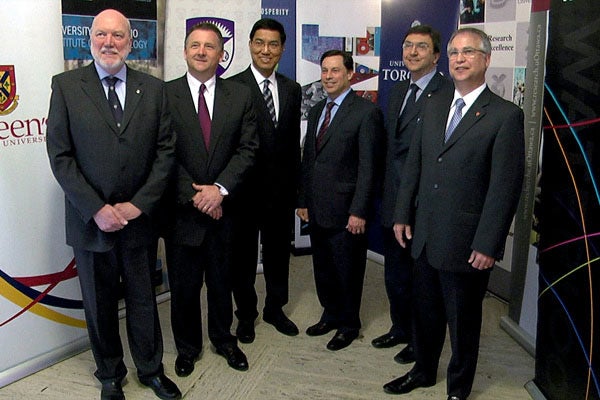
Supercomputing network proves the idea can work. Next goal: grow
Published: February 12, 2014
When a partnership of universities, business and government announced the formation of the Southern Ontario Smart Computing Innovation Platform Consortium (SOSCIP) April 2012, the project attracted attention from media and numerous corporate, academic and public sector communities.
And for good reason – this kind of collaborative research model had never been tried before in Canada.
The project included eight consortium members (IBM and seven universities: the University of Toronto, Western, McMaster, Queens, UOIT, Ottawa, Waterloo), the fastest super computer in the country – the IBM Blue Gene/Q, agile and cloud computing technology and funding from IBM ($175 million), the Government of Canada ($20 million) and the Province of Ontario ($15 million).
But SOSCIP also featured a powerful founding goal: to pursue collaborative research projects between university and private sector researchers from IBM and small- to medium-sized enterprises (SMEs) on urgent challenges facing global society: health, water, cities, energy and how advanced computing can be used to explore these problems.
The big question: could it work?
Almost two years later and SOSCIP officials believe the initiative is a runaway success. To prove its progress, SOSCIP has launched a special report and website detailing its activity and achievements.
“I think the time was right for this kind of collaborative model,” says Professor Paul Young, U of T’s vice-president, research and innovation and co-chair of SOSCIP’S board of directors with Dan Sinai, associate vice-president, research at Western.
“Universities, business and government have been moving toward models that integrate our strengths for years. We all realize that a pooling of talent can work more effectively on many topics than having organizations working independently. For example, solving our challenges with energy, especially as we try to make it greener, can’t be solved by one sector. We each have special areas of talent that can be combined to make an impact faster.”
Young points out that SOSCIP has achieved the milestones that were set out two years ago:
- more than 40 research projects are underway in priority areas
- three quarters of those projects involve partnership and collaboration with the private sector
- 21post-doctoral fellows have been engaged to provide key technical and research expertise
- 30 SMEs have become part of the partnership, with the help of the Ontario Centres of Excellence
- over 280 related jobs have been created.
Added to this is the existence of the Blue Gene/Q supercomputer located at U of T and cloud and agile computing platforms at Western.
“This technology is at the heart of SOSCIP. Big problems like traffic congestion and the analysis of climate change require massive amounts of data to enable our researchers to get at the roots of the problems. That means we need high performance computing that can handle the data. We are fortunate to have IBM as a partner in SOSCIP. We will benefit from IBM’s well-known expertise in designing software and hardware that will take our research far ahead of what we were able to do just a few years ago.
"SOSCIP has already accelerated the process of bringing concrete products and policy solutions to society in the areas of health, energy, cities and water. We have laid the foundation and we can all expect to see tangible results of our work in the very near future,” says Young.
With that in mind, Young says the next goal is growth.
“We’re not talking about getting bigger for the sake of it, but about smart expansion. We need new university and business partners to deepen our expertise on these societal issues. SOSCIP has become a success because we have strategically chosen the right partners for the right projects. And that’s what we are embarking on now – bringing in university researchers and experts from private sector businesses who have the special perspectives necessary to tackling the problems we are exploring.”
Paul Fraumeni is a writer with the Office of the Vice-President, Research and Innovation, at the University of Toronto.



